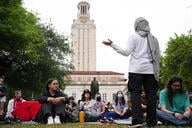You have /5 articles left.
Sign up for a free account or log in.
First steps towards carbon neutrality on virtually any campus fall in the realm of building operations. And, while it's been hard to communicate convincingly, one of the results of improving the way we operate buildings is that the people who work in them get measurably more productive.
I was reminded this morning, on my drive to campus, of just what effect things like lighting, ventilation, temperature and humidity can have on people's efficiency. The sky was gray, the humidity high, the general feel kind of dark and muggy. Now, one data point doesn't define a line, but I was struck (only figuratively) by how badly people were driving. Rolling through stop signs (even more than usual), slow to respond to green lights, bigger than normal gaps in the traffic flow (people not keeping up), average speed maybe 5 mph below the posted limit in areas where it's generally a few mph into ticket territory. Yet visibility was good, traction was fine; there was no physical constraint -- just a psychological one.
Productivity of building occupants is of special concern to colleges and universities. For most organizations, the only people whose productivity is of interest are employees. In education, though, the productivity of students is also worthy of consideration. Studies in California, Washington and Colorado have shown 7% to 26% (averaging around 20-21%) improvement in learning outcomes from improved daylighting alone. What effect would a 15-20% increase in student learning per hour have on your school's retention rates, graduation rates, grad school acceptance rates, institutional reputation? At Greenback, we'd sacrifice our Provost's first-born for that kind of improvement!
The effect on administrative worker productivity is smaller than it is on student learning efficiency. But, from a strictly-business perspective, even a small productivity increase is worth paying for. Fully-loaded employee costs per square foot typically exceed energy costs per square foot by a factor of 100 or more. That is to say, a 1% increase in average employee productivity can pay the entire energy budget for a building. But too often, investment decisions get made only in terms of hard-dollar energy savings.
Now, there's real-world data to show how investment in energy-saving technologies can both save money and improve employee efficiency. The world's biggest landlord -- the General Services Administration -- did a study of 624 workstations at 43 locations in 22 buildings around the country. Combined with a similarly-designed Canadian study, it creates the world's largest database of empirical data on employee productivity and the indoor environment.
What GSA identified is a set of seven cost-effective strategies which both save energy and improve worker performance:
1. Adjust workplace temperature for the summer months (which may not apply directly to schools following a traditional academic calendar).
2. Replace HVAC filters on schedule and with high-performance filters (reduce indoor pollution).
3. Consolidate and reduce the number of printers and copiers to achieve a ratio of 1 printer/coper for 25 workers (which they found improved employee collaboration).
4. Replace CRT monitors with LED monitors.
5. Upgrade ambient and task lighting.
6. Increase daylighting, where practical.
7. Upgrade windows for better energy performance.
Implementing all these strategies throughout federally-owned buildings is estimated to save some 568 million kWh per year. That's maybe $50 million off the Federal deficit (which is, let's be honest, chump change), but employee satisfaction levels are also improved. While the study doesn't present specifics of performance improvements, even a small decrease in employee absences or time spent kvetching could lead to a 1% increase in output.
What's good for the Feds isn't necessarily good for academe, but at least six of the seven strategies would seem good places for campus sustainability projects to start. And, who knows? If both employee satisfaction and student learning outcomes are seen to be improving, maybe the Provost will start smiling again.

